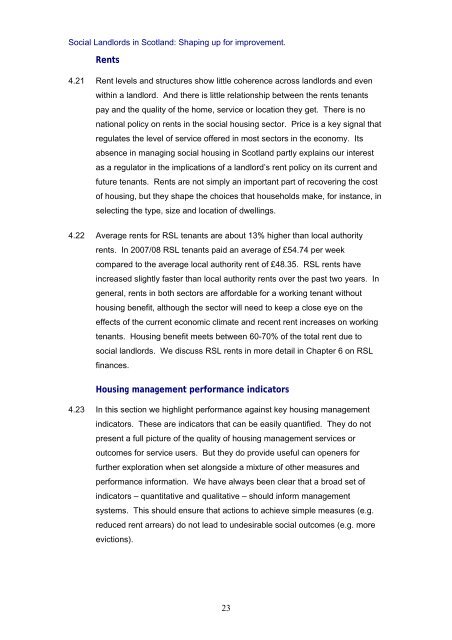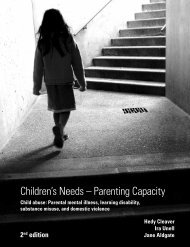Social Landlords in Scotland: Shaping up for improvement
Social Landlords in Scotland: Shaping up for improvement
Social Landlords in Scotland: Shaping up for improvement
Create successful ePaper yourself
Turn your PDF publications into a flip-book with our unique Google optimized e-Paper software.
<strong>Social</strong> <strong>Landlords</strong> <strong>in</strong> <strong>Scotland</strong>: Shap<strong>in</strong>g <strong>up</strong> <strong>for</strong> <strong>improvement</strong>.Rents4.21 Rent levels and structures show little coherence across landlords and evenwith<strong>in</strong> a landlord. And there is little relationship between the rents tenantspay and the quality of the home, service or location they get. There is nonational policy on rents <strong>in</strong> the social hous<strong>in</strong>g sector. Price is a key signal thatregulates the level of service offered <strong>in</strong> most sectors <strong>in</strong> the economy. Itsabsence <strong>in</strong> manag<strong>in</strong>g social hous<strong>in</strong>g <strong>in</strong> <strong>Scotland</strong> partly expla<strong>in</strong>s our <strong>in</strong>terestas a regulator <strong>in</strong> the implications of a landlord’s rent policy on its current andfuture tenants. Rents are not simply an important part of recover<strong>in</strong>g the costof hous<strong>in</strong>g, but they shape the choices that households make, <strong>for</strong> <strong>in</strong>stance, <strong>in</strong>select<strong>in</strong>g the type, size and location of dwell<strong>in</strong>gs.4.22 Average rents <strong>for</strong> RSL tenants are about 13% higher than local authorityrents. In 2007/08 RSL tenants paid an average of £54.74 per weekcompared to the average local authority rent of £48.35. RSL rents have<strong>in</strong>creased slightly faster than local authority rents over the past two years. Ingeneral, rents <strong>in</strong> both sectors are af<strong>for</strong>dable <strong>for</strong> a work<strong>in</strong>g tenant withouthous<strong>in</strong>g benefit, although the sector will need to keep a close eye on theeffects of the current economic climate and recent rent <strong>in</strong>creases on work<strong>in</strong>gtenants. Hous<strong>in</strong>g benefit meets between 60-70% of the total rent due tosocial landlords. We discuss RSL rents <strong>in</strong> more detail <strong>in</strong> Chapter 6 on RSLf<strong>in</strong>ances.Hous<strong>in</strong>g management per<strong>for</strong>mance <strong>in</strong>dicators4.23 In this section we highlight per<strong>for</strong>mance aga<strong>in</strong>st key hous<strong>in</strong>g management<strong>in</strong>dicators. These are <strong>in</strong>dicators that can be easily quantified. They do notpresent a full picture of the quality of hous<strong>in</strong>g management services oroutcomes <strong>for</strong> service users. But they do provide useful can openers <strong>for</strong>further exploration when set alongside a mixture of other measures andper<strong>for</strong>mance <strong>in</strong><strong>for</strong>mation. We have always been clear that a broad set of<strong>in</strong>dicators – quantitative and qualitative – should <strong>in</strong><strong>for</strong>m managementsystems. This should ensure that actions to achieve simple measures (e.g.reduced rent arrears) do not lead to undesirable social outcomes (e.g. moreevictions).23

















